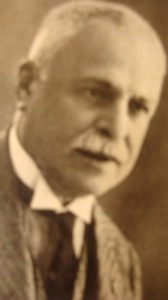Giovanni Giorgi facts for kids
Quick facts for kids
Giovanni Giorgi
|
|
|---|---|

Giovanni Giorgi
|
|
| Born | 27 November 1871 |
| Died | 19 August 1950 (aged 78) Castiglioncello, Livorno
|
| Nationality | Italian |
| Occupation | Engineer |
| Engineering career | |
| Institutions | University of Rome |
| Projects | Giorgi system of measurement |
Giovanni Giorgi (born November 27, 1871 – died August 19, 1950) was an Italian physicist and electrical engineer. He is famous for creating a special way to measure things, called the Giorgi system. This system was a very important step towards the International System of Units (SI), which is used all over the world today!
Contents
About Giovanni Giorgi
Early Life and Education
Giovanni Giorgi was born in a city called Lucca, Italy, on November 27, 1871. He studied engineering at the Institute of Technology in Rome.
His Career and Teaching
After finishing his studies, Giorgi worked at a company called Fornaci Giorgi. From 1905 to 1924, he was the director of the Technology Office in Rome. He also shared his knowledge by teaching at the University of Rome for many years, from 1913 to 1939.
Giovanni Giorgi was a respected speaker at important science meetings. He was invited to speak at the ICM three times: in Toronto in 1924, in Bologna in 1928, and in Zurich in 1932. During World War II, he moved to Ferentino.
Personal Life
Giovanni Giorgi was engaged to Laura Pisati. She was one of his former students and was also a very talented mathematician. Sadly, she passed away in 1908, shortly before they were going to get married.
His Passing
Giovanni Giorgi died on August 19, 1950, in Castiglioncello, Italy. He was 78 years old.
The Giorgi Measurement System
Toward the end of the 1800s, scientists realized that the way they measured electricity was a bit confusing. It didn't quite fit with the basic units of length, mass, and time. In 1901, Giovanni Giorgi came up with a brilliant idea.
He suggested adding a fourth unit to the existing MKS system. The MKS system used the metre (for length), the kilogram (for mass), and the second (for time). Giorgi believed that by adding a fourth unit related to electricity, all the confusing parts of electrical measurements would make more sense.
Becoming the MKSA System
In 1935, an important group called the International Electrotechnical Commission (IEC) officially adopted Giorgi's idea. They called it the M.K.S. System of Giorgi. However, they didn't yet decide which specific electrical unit would be the fourth one.
Then, in 1946, another important group, the International Committee for Weights and Measures (CIPM), agreed to use the ampere as the fourth unit. This new system became known as the MKSA system.
The Path to SI Units
The Giorgi system was a huge step forward! It was the main idea behind the International System of Units (SI), which was created in 1960. The SI system started with six base units: the metre, kilogram, second, ampere, kelvin (for temperature), and candela (for light intensity). Later, in 1971, the mole (for amount of substance) was added as a seventh base unit.
See also
 In Spanish: Giovanni Giorgi para niños
In Spanish: Giovanni Giorgi para niños

